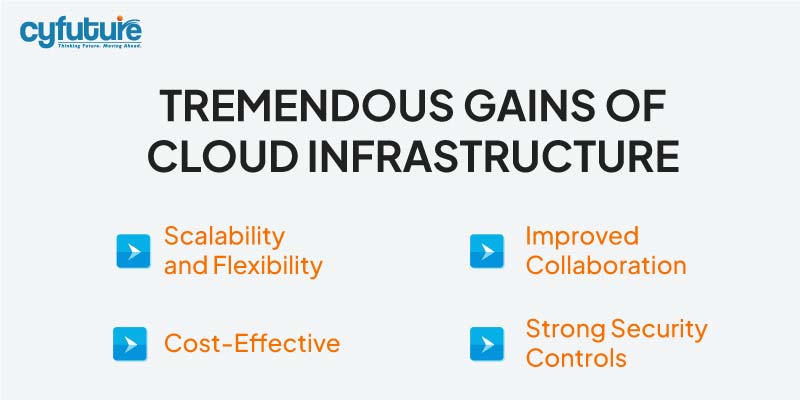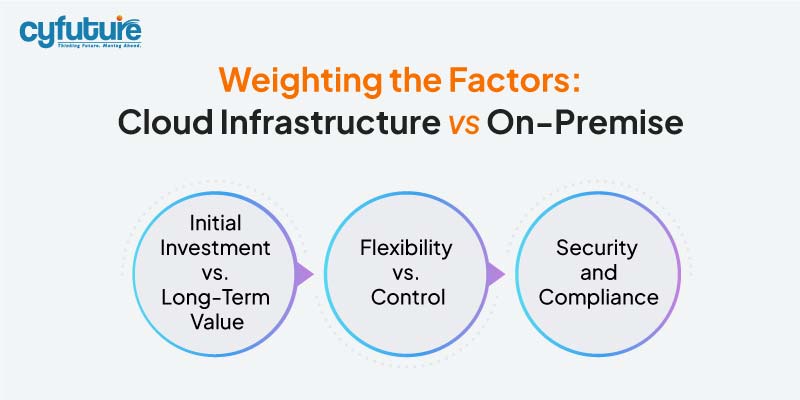-
Get Cloud GPU Server - Register Now!
Toggle navigation

With the world of digital technology constantly changing, business decisions regarding their IT infrastructure are a make-or-break proposition. One of the most critical choices for a business is whether to maintain a cloud infrastructure or keep it on-premise. As digitization grows, this decision will be further debated on which of these is superior.
This analysis will look at the pros and cons of both cloud infrastructure and on-premise systems. It will consider how they impact the scalability, security, and efficiency of the business. Cloud infrastructure boasts unmatched flexibility and scalability to the extent that organisations can scale up easily and quickly whenever a change is needed, using little to no capital.
Security is also an indispensable feature, and in many instances, it is superior to what on-premise systems can deliver. On-premise systems typically provide control over them while customisation is available, and these are critical to organisations with even more severe demands on regulatory requirements and sensitive data.
They are, however, less scalable in comparison and higher in costs of maintenance. Such knowledge is essential to any business in its desire to fully leverage its IT assets and attain sustainable growth in an increasingly digital world.
To set the contextual framework in which the debate continues to evolve, it’s important to remember the evolution of IT infrastructure. Traditionally, businesses primarily relied on the on-premise servers, and hosting hardware within their facilities was the norm. As a result, this model gave businesses complete control over their resources because they could customize settings and have direct oversight. It nevertheless incurred significant capital expenditures and a heavy maintenance overhead.
This paradigm is witnessing a sea change with the advent of cloud infrastructure. Cloud computing allows businesses to use third-party remote servers that are hosted over the internet and enjoy unprecedented flexibility and scalability. In this model, organizations can buy whatever resources they need at their disposal, and this brings expenditures in line with usage. This, of course, lightens the capital burden and increases operational responsiveness.

By nature, the most significant argument for cloud infrastructure is how fast scalability can be. Businesses can rapidly scale up or down their IT resources according to fluctuating demands. This elasticity is very useful for organisations with seasonal spikes in traffic or for organisations that want to take it to the next level without the cumbersome task of procuring additional hardware.
For instance, while demand is peaking in the business day, a vendor may easily add more computing capability to their cloud servers to absorb the bump. While during off-peak hours, resources can be repurposed to realise significant savings. This level of flexibility is effectively impossible with on-premises systems – such systems often take long lead times and heavy investments to change.
Money saving is substantial when going to the cloud. The on-premises solution requires heavy capital expenditure in terms of hardware and infrastructure and also investment in its upkeep, upgrade, and electricity consumption, whereas cloud infrastructure runs on a pay-per-use basis so that a business may allocate resources only when needed.
Moreover, the service providers usually manage maintenance and updating, allowing an in-house IT team to spend time and expertise on strategic projects instead of operational routine. This overhead decrease and conversion of some capital expenses into operational ones can notably increase a company’s financial flexibility.
In that light, cloud infrastructure improves an era of remote work by facilitating teamwork with sharpened collaboration. Through resources hosted in the cloud, employees can access applications and data even while on location anywhere with connectivity. Accessibility not only streams down workflows but also increases productivity and innovation.
Cloud collaboration tools facilitate real-time interaction among teams while working on projects without geographical bounds. Thus, an organisation is liberated and empowered to tap into any talent pool and react with a faster speed to the market dynamics.
While fear over data security often dissuades a company from migrating to the cloud, cloud security services have actually developed dramatically. Cloud service providers implement a host of controls, including data encryption, intrusion detection, and routine security audits, in place. In many cases, this will actually be more than an organisation can undertake with its security infrastructure.
Thirdly, the cloud providers have specific security teams that ensure that they keep pace with industry standards to maintain and preserve security compliance. Such teams will be able to pinpoint and minimise risk by improving the overall position of an organisation’s security in the age of sophisticated cyber attacks.
The first advantage of on-premise systems is the ability to be totally in control. Organizations will be in a position to configure the infrastructure to specific or unique operational requirements, hence having solutions tailored to their business goals. This includes control over data management, security protocols, and compliance standards, which gives organizations a sense of ownership over their IT environment.
For regulated industries such as finance and healthcare, such sensitive data is preferred to be kept in-house. Since on-premise solutions allow organizations to customize security aspects for practices with data handling that meet the standards of regulations, it may be preferred.
Although great money is pumped into the on-premise solutions at first, the long-term cost predictability of such solutions may be higher. After the purchase of hardware and software, costs escalate by a linear increment, including the costs of maintenance, power intake, and, sometimes, updates. Organizations with tight budgeting might cherish this predictability.
In addition, organizations that invest in on-premises infrastructure from the very beginning will stick to the use of the assets that have already been installed rather than incur the new costs of migrating to the cloud.
This is because most organizations have legacy systems as part of their core operations. Compatibility with such systems is much higher with on-premise solutions, which enable easy integration without risking a mass shift to a new infrastructure. Businesses can slowly move the IT environment toward modernization without having to revamp the entire system all at once.

The financial implications of cloud infrastructure compared to on-premise systems can be analyzed with the help of initial investment and long-term value. Compared to the two, cloud infrastructure usually provides lower initial investment than on-premise systems. Thus, it is an attractive option for start-ups seeking minimum capital expenditures. Conversely, on-premise systems tend to involve significant investments initially, and in return, they offer stability and predictability over long-term costs.
The debate between flexibility and control really lies at the heart of the argument. Cloud infrastructure provides elastic scalability and adaptability unparalleled anywhere else, and this resultant benefit is that they can react very quickly to changes in market trends. However, such flexibility often loses control over data management and security.
On-premise systems ensure that an organization maintains complete control over its IT environment, but it may need to be more agile to cope with today’s lightning-fast business environment. Organizations need to carefully weigh their concerns and settle for an option that best suits their needs to optimize operations.
The security of data continues to be the area that cuts across all businesses. Even though the current providers have improved their mechanisms, including security, the companies should select one that complies with industry regulations.
Companies that deal in highly regulated industries may need this feature because data might need to be stored onsite for compliance. In contrast, the advanced security features that cloud vendors offer may add additional layers to overall cybersecurity.
Cloud migration services can well be employed by organizations that plan to move their infrastructures from on-premises to the cloud. The services comprise an expansive range of components that include assessment of the current infrastructure, planning, and eventually executing the entire process of migration. This is because, with the use of experts, firms are able to avoid traps and ensure that they go about their migration efficiently in line with strategic goals.
With cloud migration services, organizations can optimize their cloud environments after the migration process has been carried out and benefit accordingly with the maximum out of their new infrastructure. Such optimization can yield better performance, cost savings, and scalability.
As organizations start to move toward hybrid models that bring together the best of cloud and on-premise solutions, flexibility and adaptability will characterize the future IT infrastructure. Businesses will always choose the unique needs of the organizations and reconfigure their IT environments according to those requirements, thus “playing off the strengths of both approaches.”
In fact, it is no longer an either-or proposition; the decision between choosing cloud infrastructure versus on-premise systems is really a continuum of possibilities where the organization balances scalability, control, security, and cost. Businesses will find a way to cut through complexities by conducting an accurate analysis of operational requirements and strategic objectives.
The debate over cloud infrastructure versus on-premise solutions is by no means open-and-shut. Each approach has its advantages and disadvantages, and the best choice would then be seen as contingent on the specific needs and circumstances facing each organization. As organizations continue to navigate the complexities of the digital landscape, they must address a number of critical considerations, such as flexibility, security, and scalability. There are three basic options to consider:
It is not only a technical decision but a strategic imperative that helps redefine how organizations operate and compete. Similarly, with cloud migration services and robust cloud security services by your side, companies can dive headfirst into this digital transformation path to seize opportunities in an increasingly interconnected world.
Through critical evaluation of the options of their IT infrastructures, businesses can ultimately realize the potential power of technology to gain a sustained competitive advantage and foster innovation in this dynamic marketplace. Whether it is optimizing cloud servers or enhancing operational efficiency, business infrastructures are all bright lights if organizations choose wisely.